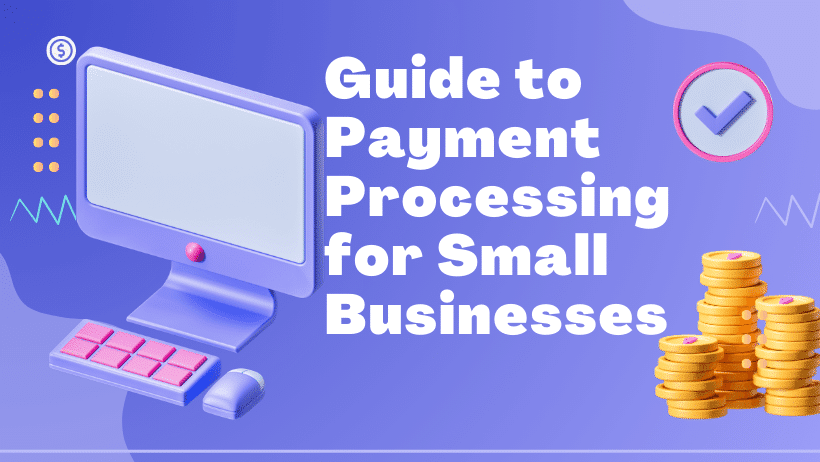As a small business owner, navigating the world of payment processing can be overwhelming. From choosing the right payment processing for small businesses to understanding the fees and regulations, there’s much to consider.
In this comprehensive guide, we’ll walk you through everything you need to know about payment processing, including the different payment methods, the top payment processors for small businesses, and tips for choosing the right solution for your specific needs.
This guide is for anyone who wants to streamline their transaction handling, whether they are just starting out in business or upgrading an existing payment management system. Join us to help demystify payment handling. We will also show you how to take your small businesses to the next level.
Understanding Payment Processing
Payment processing refers to handling electronic transactions between a customer and a merchant. It involves the authorization, authentication, and settlement of these transactions. Understanding transaction handling is essential for businesses to effectively manage their cash flow and provide a seamless experience for their customers.
It involves understanding the different types of payment methods, such as credit cards, debit cards, electronic checks, and digital wallets, as well as the various steps involved in processing payments, including authorization, capture, and settlement.
It also involves understanding the role of payment gateways, merchant accounts, and acquirers and the associated fees and security measures.
By understanding funds transfer facilitation, businesses can choose the most appropriate transaction processing solution for their needs, ensure compliance with industry regulations, and provide customers with a secure and convenient payment experience. This understanding can help businesses improve their revenue streams and customer satisfaction.
Basics of Payment Processing
Payment processing is the process of handling payment transactions securely and efficiently. When a customer makes a purchase, their payment details are encrypted and sent to a payment portal, which then communicates with the customer’s bank to verify the funds and transfer them to the merchant’s bank account.
Several key players are involved in payment management, including the customer, merchant, payment channel, and acquiring bank.
Think of the payment channel as your business’s trusty mediator. It seamlessly bridges the gap between your customer and the bank, making sure that every transaction not only feels secure but also dances in harmony with all the industry regulations. It’s the unsung hero ensuring a smooth and compliant financial performance.
The acquiring bank takes in funds from the client’s bank and securely places them into the merchant’s accounts. Money transaction processing encompasses a series of steps, such as authorization, authentication, and settlement.
Businesses need a financial transaction handling system that is reliable to accept different forms of payment, and offer a seamless customer experience.
Importance of Payment Processing for Businesses
Payment processing is essential for businesses for several reasons:
- Seamless customer experience: It empowers businesses to embrace various payment procedures, including credit and debit cards, digital wallets, and online payment platforms.
- Increased sales and revenue: With transaction handling, businesses can reach a wider customer base and attract more sales. Businesses can increase sales by offering multiple payment systems.
- Security and fraud protection: Funds transfer facilitation systems have security and fraud protection measures that protect sensitive customer information and prevent fraudulent transactions.
- Speed and efficiency: Payment management allows for quick and efficient transactions, reducing the time and effort required to complete a sale.
- Financial reporting and analysis: Payment systems provide businesses with detailed transaction reports and insights, which can be used for financial reporting, analysis, and decision-making. This helps businesses understand their sales trends, customer behavior, and financial performance.
Overall, payment management is crucial for businesses to drive sales, improve customer satisfaction, enhance security, and streamline operations, ultimately contributing to business growth and success.
Different Types of Payment Processing
Understanding different payment processing types is vital for businesses to meet customer demands and individual preferences effectively. Here are six payment management types you should consider when meeting those demands:
- Credit card processing involves using a credit card terminal or digital payment gateway to process payments made with a credit card.
- Debit card processing: Much like credit card processing, this entails utilizing a terminal or gateway to handle payments made with a debit card, deducting the amount directly from the cardholder’s bank account.
- E-wallet payments: Digital wallets such as PayPal, Google Pay and Apple Pay allow users to store their payment details and make purchases online or in stores with just a couple of clicks or swipes.
- Mobile payments include payments made through mobile apps or wallets using technologies like QR codes, NFC, or contactless payment channel.
- ACH processing: Automated Clearing House (ACH) payments allow for electronic transfers between financial institutions, often used for direct deposits, bill payments, and e-checks.
- Online banking payments: Through online banking services, customers can conveniently execute payments directly from their bank accounts, typically facilitated by a secure login and authorization process.
- Cryptocurrency payments: Some businesses accept payments in cryptocurrencies like Bitcoin, Ethereum, and Litecoin, using digital wallets and blockchain technology for secure and decentralized transactions.
How Payment Processing Works?
Understanding how payment processing works is crucial for businesses and consumers alike. The process involves several steps and players, from swiping a credit card to online transactions. Let’s delve into the intricacies of financial transaction handling and how it impacts our daily financial transactions.
- Payment management involves transferring funds from a customer’s account to a business’ account. This is a simplified explanation of the financial transaction handling process.
- Customer submits payment: The customer initiates a payment by swiping a credit/debit card, entering card information online, or using a digital wallet.
- Authorization: Payment information is sent to a payment processor who then contacts the bank of the customer to verify funds and approve the transaction.
- Settlement: The payment processor will send the payment information, once the transaction has been approved, to the bank of the business to transfer funds. This usually happens between 1-2 business day.
- Funds transfer: The funds from the customer’s bank are transferred to the business’s bank account, completing the transaction.
- Reporting: The payment processor and the business receive a transaction report showing the payment details and any associated fees.
A payment interface or merchant services provider typically handles this entire process, acting as the intermediary between the customer, their bank, the business, and the business’s bank.
Benefits and Limitations
Payment processing has revolutionized how businesses operate, providing convenience and transaction speed. However, there are also limitations and potential risks that businesses must be aware of when it comes to transaction handling.
Benefits:
- Convenience: Transaction handling makes it easy for customers to purchase online or in person using various payment systems.
- Security: It offers secure transactions, reducing the risk of fraud and theft.
- Faster transactions: Processing payments electronically can speed up the payment management, reducing the time it takes for funds to become available.
- Increased sales: Accepting multiple payment techniques can help businesses attract customers and increase sales.
- Streamlined operations: Financial transaction handling systems can integrate with accounting and inventory management systems, making tracking transactions and managing finances easier.
Limitations:
- Costs: The fees can eat into profits, especially for small businesses.
- Risk of chargebacks: Customers may dispute charges, leading to chargebacks and potential loss of revenue.
- Technical issues: Their systems can experience downtime or technical difficulties, leading to disruptions in the process.
- Fraud risk: Despite security measures, their systems are still vulnerable to fraud and unauthorized transactions.
- Complexity: Handling a variety of payment techniques and staying current with ever-changing regulations and compliance requirements can prove intricate and demand a significant amount of time.
Payment Processing Providers
Payment processing providers are crucial in facilitating seamless and secure transactions for businesses of all sizes. Whether online sales, in-store purchases, or wireless payments, these providers offer various services to ensure that money changes hands efficiently and safely.
The providers are the link between financial institutions and merchants. They enable accepting different payment techniques, such as debit cards, digital wallets, and credit cards. They also offer solutions for fraud detection and prevention and chargeback management to protect both the merchant and the consumer.
As the world increasingly leans towards e-commerce and the popularity of contactless payments rises, the need for dependable providers has reached unprecedented levels.
In the ongoing adaptation of businesses to the changing payment landscape, the significance of these providers becomes increasingly crucial in propelling economic growth and fostering innovation.
We will explore the importance of transaction handling providers and their various services to help businesses thrive in today’s digital economy.
Top Providers for Small Businesses
Small businesses often need help finding the right provider that fits their budget and needs. With so many options available, it can be overwhelming to make the right choice.
We have chosen the top payment processing providers for small businesses to help you make an informed decision below:
- Square: Square offers simple and affordable solutions for small businesses, including point-of-sale systems, web payments, and invoicing options.
- PayPal: PayPal provides a range of services for small businesses, including e-payments, in-store payments, and invoicing options.
- Stripe: Stripe offers a range of online and in-person financial transaction handling solutions for small businesses, including in-app payments, subscriptions, and customizable payment systems.
- Intuit QuickBooks Payments: Intuit QuickBooks provides payment management solutions for small businesses, including online payments, in-person payments, and invoicing options.
- Authorize.Net: Authorize.Net offers a range of solutions for small businesses, including digital payments, in-store payments, and subscription billing options.
- Payline Data: Payline Data provides financial transaction handling solutions for small businesses, including in-store payments, web payments, and recurring billing options.
- Fattmerchant: Fattmerchant offers solutions for small businesses, including in-person, online, and recurring billing options.
- PaySimple: PaySimple provides solutions for small businesses, including e-payments, in-store payments, and invoicing options.
- Dharma Merchant Services: Dharma Merchant Services offers solutions for small businesses, including in-person payments, web payments, and wireless payment options.
- BluePay: BluePay provides transaction handling solutions for small businesses, including in-store payments, digital payments, and virtual terminal options.
Setting Up Payment Processing Providers
Setting up payment management providers for your business is an essential step to start accepting and processing payments from your customers. Here are the steps you can follow to set up financial transaction handling providers:
- Research and compare providers: Start by researching different providers and comparing their features, fees, and customer reviews. Look for providers that offer your business the right mix of services, such as credit card processing, digital payments, e-commerce options, and more.
- Choose the right provider: Once you have narrowed your options, choose the provider that best fits your business needs. Consider transaction fees, setup costs, contract terms, and customer support.
- Sign up for an account: Once you have chosen a provider, sign up on their website. You may need to provide your business information, banking details, and other documentation as required.
- Set up your merchant account: After signing up, you must set up a merchant account with the provider. This account will be used to receive and process payments from your customers.
- Integrate the payment gateway: If you have an e-commerce website or online store, you must integrate the transaction platform provided by your provider. This enables your customers to securely conduct internet transactions.
- Test the payment system: Before going live, it’s essential to test the transaction handling system to ensure that it is functioning correctly. Ensure you can process payments, issue refunds, and access reporting and analytics tools.
- Train your staff: For employees tasked with payment handling, provide training on the effective and secure use of the financial transaction handling system.
- Go live: Once everything is set up and tested, you can start accepting customer payments using the provider.
- Monitor and optimize: Regularly monitor your system for any issues or opportunities for improvement and optimize it as needed to ensure a smooth and secure customer payment experience.
Fees and Terms for Providers
The fees and terms associated with providers may differ based on the particular provider and the services they provide. Some common fees and terms to consider when evaluating payment management providers include:
- Transaction Fees: Most providers charge a fee for each transaction. This fee can vary based on transaction volume, payment procedure, and risk level.
- Monthly Fees: A monthly fee may be imposed by certain providers for access to their services, encompassing features such as account maintenance, customer support, and reporting.
- Contract Length: Many providers require merchants to sign a contract with a minimum time, such as one to three years. Early termination fees may apply if the contract is ended before the agreed-upon term.
- Payment Method Acceptance: Various providers may endorse diverse payment procedures, ranging from credit cards and debit cards to ACH payments and mobile wallets. It’s crucial to opt for a provider aligning with the payment systems preferred by your customers.
- Chargeback Fees: Chargebacks arise when a customer disputes a charge, resulting in the funds being returned to the customer. Certain providers may impose a fee for handling chargebacks.
- International Transactions: If your business sells to customers outside your home country, it’s important to consider the fees and terms for processing international transactions, including currency conversion and cross-border transaction fees.
- Integration and Setup Fees: Some providers charge fees for integrating their services with your website or point-of-sale system, as well as for setting up your account and providing initial training.
It’s important to carefully review the fees and terms of any provider before considering the overall value and level of service provided and the costs.
Online Payment Processing
Online payment processing is the digital process of accepting, verifying, and completing a payment online. The security of this service hinges on reliable payment gateways and encryption technology, guaranteeing the safety and protection of customers’ financial information.
Online processing accommodates a range of payment options, encompassing credit and debit cards, digital wallets, and bank transfers. Online transaction handling allows businesses to expand their customer base by offering a convenient and accessible purchase method.
It also streamlines the payment management, reducing the risk of human error and the time it takes to complete a transaction. Additionally, e-payment management provides valuable data and insights for businesses, allowing them to track and analyze customer spending habits and preferences.
In essence, online financial transaction handling has transformed the landscape of business operations in the digital era, offering a smooth and secure avenue for customers to conduct transactions and businesses to receive payments.
Essentials of Online Payment Processing
For any e-commerce venture, online transaction handling stands as a fundamental component, emphasizing the importance of comprehending its key elements. The first essential element is security.
Customers need to feel confident that their financial information is being handled securely. Working with a reliable transaction platform that offers encryption and fraud prevention is crucial. Another essential consideration is convenience.
The transaction handling should be seamless and user-friendly, allowing customers to make purchases with minimal effort. It is also important to have various payment options available to accommodate different customer preferences. Additionally, speed is a critical aspect of internet transaction management.
Customers desire swift and efficient processing of their transactions.
Finally, it is crucial to stay informed about industry regulations and comply with them to ensure that the payment management meets legal requirements. By prioritizing these essentials, businesses can provide their customers with a smooth and secure internet transaction experience.
Security Aspects of Online Payment Processing
The security aspects of online payment management are paramount in today’s digital age. With the increasing number of online transactions, there is a growing need to ensure that customer’s financial information remains secure.
Several measures have been put in place to protect the sensitive data involved in web payments:
- Encryption: This converts sensitive information into an unreadable format to prevent unauthorized access. It is essential for web payment management to use strong encryption protocols to protect customer payment details and transaction information.
- Secure Sockets Layer (SSL): SSL is a standard security technology for establishing a secure web server and browser connection. It guarantees that all data exchanged between the web server and browser stays encrypted and secure. For websites handling payments, possessing an SSL certificate is imperative to guarantee the security of online transactions.
- Payment Card Industry Data Security Standard compliance: Adherence to the PCI DSS is essential for both merchants and payment processors. These security standards are crafted to guarantee that every company handling credit card information—whether accepting, processing, storing, or transmitting—upholds a secure environment. This includes implementing secure network configurations, protecting cardholder data, and regularly monitoring and testing their systems for vulnerabilities.
- Fraud detection and prevention: Robust fraud detection and prevention measures are crucial for digital payment processors to recognize and mitigate potential fraudulent transactions effectively. This might involve the utilization of machine learning algorithms to spot unusual patterns or behaviors, incorporating address verification systems, and mandating extra authentication for transactions deemed high-risk.
- Two-factor authentication: Implementing an additional security layer, two-factor authentication necessitates users to furnish two forms of verification prior to concluding a transaction. This could involve a combination of a password and a distinctive code sent to the user’s mobile device, or biometric authentication methods like fingerprint or facial recognition.
- Tokenization: Tokenization substitutes sensitive information, like credit card numbers, with distinct identifiers known as tokens. This helps to protect sensitive information and reduces the risk of data breaches.
- Regular security updates and maintenance: Regularly updating and maintaining their systems is essential for digital payment processors to shield against the latest security threats and vulnerabilities.
- Secure third-party integrations: If utilizing third-party payment gateways or other service providers, it is important to ensure that these partners also have robust security measures to protect customer data during payment.
By implementing these security measures, digital payment processors can help protect customer data, prevent fraudulent transactions, and build trust with their users.
Integration of Online Payment Processing
Online payment processing integration refers to incorporating a transaction platform or processor with a website or digital platform to enable smooth and secure online transactions. This integration can be achieved through various means, including application programming interfaces (APIs), software development kits (SDKs), or third-party platforms.
The integration of online transaction handling requires several key steps:
- Selecting a Payment Gateway or Processor: The initial step involves selecting a dependable and secure transaction platform or processor tailored to the business’s specific needs. Considerations should encompass transaction fees, security features, supported payment options, and integration options.
- Obtaining API or SDK: Once a payment processor is chosen, the next step is to obtain the necessary API or SDK documentation and credentials to begin the integration process.
- Incorporating Payment Options: Integration involves adding payment techniques to the website or platform, such as credit/debit cards, digital wallets, and alternative payment techniques. This may involve creating a checkout page, implementing a secure payment form, or embedding payment buttons.
- Customizing User Experience: Businesses can customize the transaction handling to provide a seamless and branded user experience. This may include adding custom fields, branding the payment page, and providing multiple language and currency options.
- Testing and Security: Before going live, thorough testing of the payment integration is essential to ensure that transactions are processed accurately and securely. This includes testing different payment scenarios, error handling, and security features like encryption and fraud protection.
- Compliance and Regulations: Ensuring compliance with industry regulations and standards, such as PCI DSS (Payment Card Industry Data Security Standard), is crucial to maintaining data security and protecting customer payment information.
- Maintenance and Support: After integration, ongoing maintenance and support are necessary to address issues, update security protocols, and incorporate new features or payment systems.
By integrating online transaction handling, businesses can provide a convenient and secure customer payment experience, increase sales and revenue, and streamline their overall operations.
Mobile Payment Processing
Mobile payment processing involves utilizing a mobile device, such as a smartphone or tablet, for accepting and processing customer payments. This can be done through various methods, including mobile wallets, QR code scanning, and mobile card readers.
Mobile transaction handling offers convenience for businesses and customers, allowing for quick and easy transactions without traditional cash or card payments. Many businesses, particularly small businesses and independent vendors use digital payment management to accept payments on the go, at events, or in remote locations.
Various digital payment management solutions are available, including third-party apps and services, as well as integrated solutions from banks and financial institutions. These solutions often come with transaction tracking, inventory management, and customer data collection features.
Mobile transaction handling is often considered a secure and reliable option for businesses, with many solutions offering encryption and fraud protection measures. It also provides a seamless and efficient way for customers to make payments, enhancing the overall customer experience.
In essence, mobile transaction handling provides a convenient and efficient method for businesses to handle payments and for customers to make purchases. It’s becoming an increasingly favored choice in today’s digital economy.
Credit Card Processing
Credit card processing is how businesses and merchants accept and process payment transactions made by customers using credit cards. It involves using a credit card terminal or POS system to capture and transmit payment information to financial institutions.
The process typically includes authorization, where the card issuer approves the transaction and verifies the availability of funds, followed by settlement, where the funds are transferred from the customer’s account to the merchant’s.
With technological advancement, credit card processing has evolved to include online and mobile payment channel, making it more convenient for businesses and customers.
Security measures such as encryption and tokenization are also in place to protect sensitive payment information and reduce the risk of fraud. With the increasing popularity of electronic payments, credit card processing remains an integral element of modern commerce.
Understanding Credit Card Processing
Credit card processing is the method by which businesses and merchants accept and authorize payments from customers using credit and debit cards. This process involves several steps, including authorization, capture, and settlement.
Authorization: When a customer makes a purchase with a credit or debit card, the merchant contacts the card-issuing bank to verify that the customer has enough funds available to make the purchase. The bank then gives an authorization code to the merchant, indicating that the transaction is approved.
Capture: Once the transaction is authorized, the merchant captures the payment details and submits them to their payment processor for settlement. This step finalizes the transaction and prepares it for the next step.
Settlement: The payment processor sends the transaction details to the card network, which then transfers the funds from the customer’s bank to the merchant’s bank. This process usually takes a few days to complete, after which the merchant receives the funds from the transaction.
Credit card processing also involves fees, including interchange fees, which are paid to the card-issuing bank, as well as fees for the payment processor and the card network. These fees can vary depending on the type of card used, the size of the transaction, and other factors.
Overall, credit card processing allows businesses to accept card payments from customers, providing convenience and security for both parties involved in the transaction.
Credit Card Processing Fees
Credit card processing fees are fees imposed by merchant account providers and payment processors for the management and processing of credit card payments.
These charges usually encompass interchange fees (imposed by credit card networks such as Visa and Mastercard), assessment fees (levied by the credit card networks for their services), and a markup fee charged by the payment processor or merchant account provider. The exact fees and rates can vary depending on the specific provider and transaction type.
How to Choose a Credit Card Processor?
When choosing a credit card processor for your business, there are several factors to consider. By carefully considering these factors, you can choose a credit card processor that best fits the needs of your business.
- Compare pricing: Look for a credit card processor that offers competitive rates and fees, including interchange fees, transaction fees, and monthly fees. Make sure to consider the total cost of processing credit card payments before making a decision.
- Consider your business needs: Every business has different needs when it comes to credit card processing. Consider factors such as the types of payment methods you want to accept (e.g. chip cards, contactless payments), the volume of transactions, and the average transaction amount.
- Research customer support: Look for a credit card processor that offers reliable and responsive customer support. You’ll want to have assistance available in case of any issues with your transaction handling system.
- Check for security features: It’s important to prioritize the security of your customers’ payment data. Look for a credit card processor that offers advanced security features, such as PCI compliance and data encryption.
- Evaluate integration options: If you use a point-of-sale system or e-commerce platform, make sure that the credit card processor you choose can integrate seamlessly with your existing software.
- Read customer reviews: Before choosing a credit card processor, take the time to read reviews from other business owners. This will give you insight into the experiences of other customers and help you make an informed decision.
- Look for additional features: Some credit card processors offer additional features and services, such as reporting tools, analytics, and loyalty programs. Consider whether these features would be valuable for your business.
As we conclude this ultimate guide to payment processing for small businesses, remember that the choices you make in managing transactions are pivotal to the success and growth of your venture.
Remaining abreast of current trends, adopting secure and effective payment methods, and giving priority to your customers’ preferences positions your small business for lasting success in the competitive marketplace.
The journey of payment management may seem intricate, but armed with the insights from this guide, you’re well-prepared to navigate the landscape confidently.







